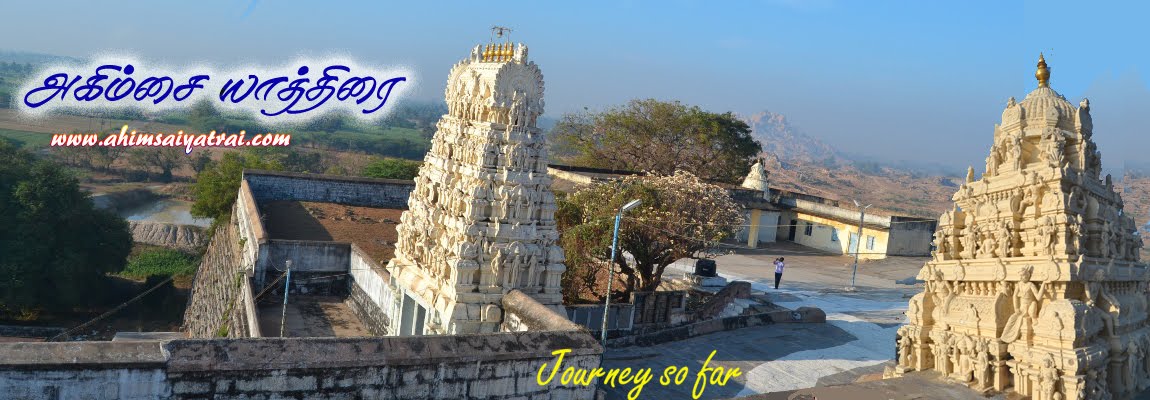JAIN FLAG - சமணக் கொடி
சமண பஞ்சவர்ணக்
கொடி படுக்கையாக (கிடைமட்ட) ஐந்து வண்ணங்களை கொண்டு அஹிம்சையை நிலைநாட்டும் ஸ்தலங்களில்
பறக்கவிடப்படுகிறது. குங்குமப்பூ (சிகப்பு), மஞ்சள், பச்சை, கரும்நீலம் (கருப்பு)
மேலிருந்து கீழாக சம அளவில் அமைக்கப்பட்டுள்ளது. வெள்ளை இரு மடங்கு அகல அளவில் இருக்கும். கொடியின் அளவு, ஐந்து வண்ணத்துடன் மொத்தத்தில் மூன்றில் இரண்டுமாக
நீள, அகலம் அமைக்கப்பட்டுள்ளது.
நடுவிலுள்ள்
வெள்ளை நிறபகுதியில் ஸ்வஸ்தீகம் மேல் மூன்று புள்ளிகளுடனும்; அதன் மீது, பிறைவடிவு மேற் ஒரு புள்ளியுடனும் காட்சி தருகின்றன.
ஸ்வஸ்தீகம் தேவ, மனித, விலங்கு, நரக என்னும் நான்கு கதிகளை ஆரமாக கொண்ட சக்கரமாக பிறவிச்
சுழற்சியை குறிக்கும் அடையாளமாகவும்; மேற்
புள்ளிகள் மூன்றும் விடுதலைப் பேற்றை வழங்கும் நற்காட்சி, நல்ஞானம், நல்லொழுக்கத்தை
குறிப்பதாகவும்; பிறை சித்தலோகத்தையும்; மேற்புள்ளி விடுதலை பெற்ற சித்தாத்மாக்களையும்
குறிக்கும் முகமாக அமைக்கப்பட்டுள்ளது.
ஐந்து வண்ணங்களும் இருபத்து நால்வரின் வண்ணங்களை வகைப்படுத்தும் வண்ணமாகவும் அதாவது சந்திரப்பிரப/புஷ்பதந்த தீர்த்தங்கரர் வெண்நிறமாகவும், முனுசுவிரத/நேமிநாதர் கருநீலம்/கருப்பாகவும், பத்மபிரப/வாசுபூஜ்ய
இருவரும் சிவப்பாகவும், மல்லிநாத/ பார்ஸ்வநாதர் பச்சை நிறமாகவும் மற்ற தீர்த்தங்கரர்கள்
பொன்னிறமாகவும் இருப்பதை சுட்டுகிறது.
போற்றுதற்குரிய ஐங்குரவர்களான அரஹந்தர், சித்தர், ஆச்சார்யர், உபாத்தியாயர், சர்வ சாதுக்களை தெரிவிக்கும் முகமாகவும் அமைந்துள்ளது. குங்குமப்பூ நிறம் ஆச்சார்யருக்கு சொந்தமாக உள்ளது. மேலும் சமண, பெளத்த, இந்து மதங்களில் பல புனித நிகழ்வுகளில் பயன்படும் நிறமாக கொண்டது.
இக்கொடிக்கான
தொன்மையை நிர்ணயிக்க முடியாதுள்ளது. அநேக இடங்களில் வாழும் சமணர்களிடையே காண முடிகிறது.
பெரும்பாலும் ஆலய கோபுரங்களின் மேற் பறக்க விடப்பட்டும், சமய ஊர்வலங்களில் முன்னின்றும், ஆலய நிகழ்வுகளுக்கு
முன்னர் கம்பத்தில் ஏற்றப்படுவதுமாக வழக்கத்தில் உள்ளது. மேலும் துவஜம் என்ற பெயரில்
முற்காலத்தில் வழங்கப்பட்டும், ஜினமாதாவின்
கனவில் தோன்றியதாகவும் ஆகமங்களில் குறிக்கப்பட்டுள்ளது. அவற்றிலிருந்து அதன் தொன்மையை அறியலாம்.
The Jain
flag has five horizontal bands of different colours. From top to bottom, the
colours are red, yellow, white, green and dark blue, or black. Three times in
lengthwise and two times in breadthwise.
In the
centre, on the white band, is a svastika, with three dots above it and a
crescent at the top. The dot above the crescent represents a liberated soul.
These are all in orange.
The colours
used in the flag are significant. The coloured bands are the emblematic hues of
the 24 Jinas and can also represent the Five Holy Entities, who are very
honoured in Jainism.
It is also
believed that the complexion of all the 24 Tirthankaras was of one of these 5
colours. For instance, Chandraprabha and Pushpadanta were white, Munisuvrata
and Neminatha were blue or dark colour, Padmaprabha and Vasupujya were red,
Mallinatha and Pārśva were green, while the remaining were golden or yellowish.
The colour
orange is associated with one of the Five Holy Entities, namely the ācārya or
head monk. Shades of orange and saffron have been linked with religion in India
for millennia and orange robes are often worn in religious ceremonies by Hindus
and Buddhists as well as Jains.
The origin
of the flag is difficult to pin down but it has become fairly widespread in all
Jain places. It is frequently seen flying from the top of temples and is
commonly paraded in the processions,hoisted before commencement of Jain
festivals. It could have an ancestor in the banner – dhavja – which is one of
the auspicious dreams of Jina Madha and, as such, is holy.





No comments:
Post a Comment